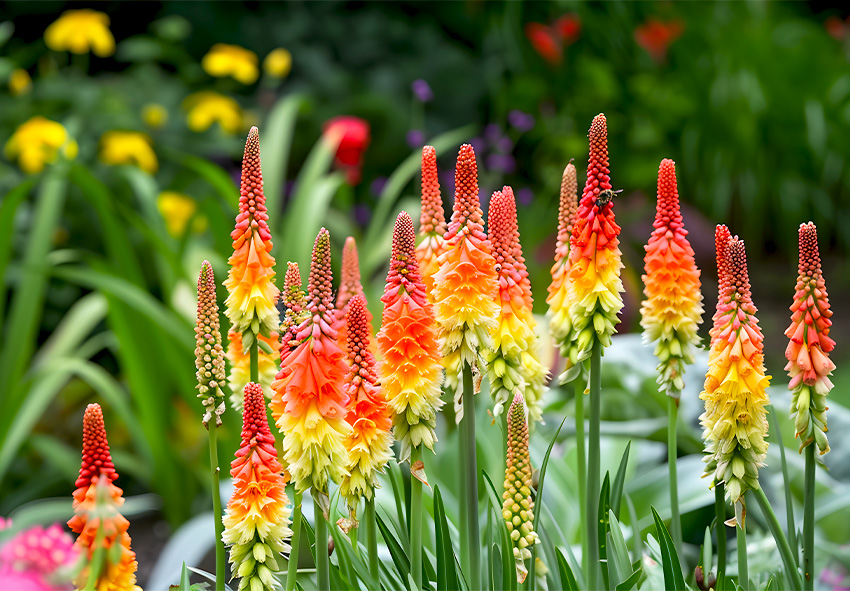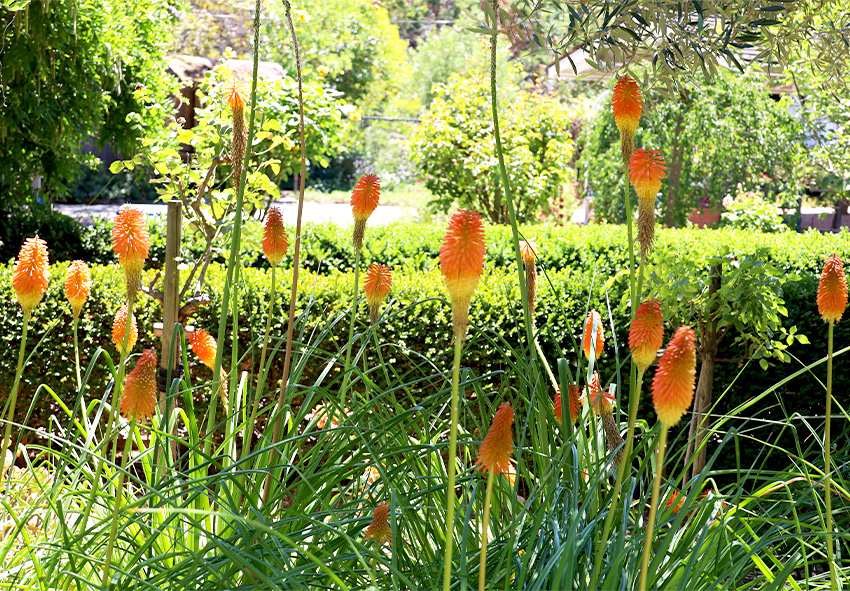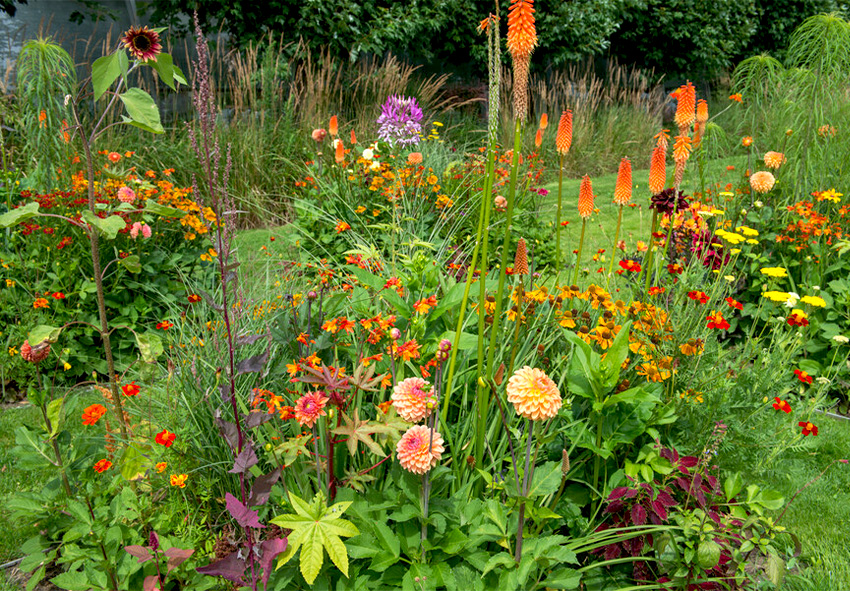Kniphofia, also known as Red Hot Poker, is a bold and architectural perennial that adds dramatic flair to any garden space. Its vibrant, torch-like flower spikes and grass-like foliage make it a favorite for both contemporary and cottage-style landscapes. In this article, you’ll learn how to incorporate Kniphofia into garden design, discover ideal companion plants, and explore seasonal care tips. Our gardening blog is a perfect place to find all the information you need!
Using Kniphofia in Landscape Design

Kniphofia, also known as Red Hot Poker, adds bold structure and vibrant color to landscape compositions. Its tall flower spikes make it an ideal focal point or accent plant in a variety of garden settings.
Creating Vertical and Color Contrast
Kniphofia’s tall, striking blooms can reach up to four feet, making them excellent vertical accents in borders or mixed beds. Their fiery hues — ranging from red and orange to soft yellows — create eye-catching contrast against cooler-colored plants. Placing them against a neutral backdrop, like a stone wall or green foliage, helps them truly pop.
Tropical and Drought-Tolerant Themes
These perennials thrive in full sun and well-drained soil, making them perfect for dry, xeriscape, or Mediterranean gardens. Their exotic flowers pair beautifully with tropical-looking companions such as canna lilies or banana plants. Despite their lush look, Kniphofia is remarkably drought-tolerant once established.
Cottage, Coastal, and Contemporary Uses
Whether you’re going for a loose cottage border or a clean-lined modern aesthetic, Kniphofia adapts well. In cottage gardens, they complement softer blooms like daisies and salvia. In coastal settings, their salt-tolerant nature and sturdy stems help them withstand windy conditions.
Best Companion Plants for Kniphofia
Pairing Kniphofia with complementary plants can enhance both its beauty and your overall garden aesthetic. Choosing the right companions also helps create a balanced ecosystem and support diverse growing conditions. Here are some plant categories:
- Perennials for Color Harmony: For a cohesive look, combine Kniphofia with perennials like Coreopsis, Rudbeckia, and Echinacea. These plants share a similar bloom time and sun-loving habit. The warm yellows and oranges echo Kniphofia’s vibrant tones, creating a unified, energetic palette.
- Foliage Plants for Contrast: To enhance Kniphofia’s upright habit, mix in foliage-focused plants like ornamental grasses, agave, or yucca. These low-maintenance options provide textural contrast while allowing Kniphofia’s flowers to shine. Their shapes and forms complement the Red Hot Poker’s spiky silhouette without overwhelming it.
- Pollinator-Friendly Partners: Kniphofia is loved by hummingbirds, bees, and butterflies, and pairing it with other pollinator magnets boosts biodiversity. Good companions include lavender, catmint, and bee balm. Together, they create a vibrant, living space full of movement and sound.
Seasonal Interest and Blooming Period

Kniphofia offers long-lasting seasonal color, with blooms that span from late spring to early fall, depending on the variety. Knowing how to care for Kniphofia and when it blooms helps in planning your garden for continuous visual interest.
When Kniphofia Blooms
Most Kniphofia varieties bloom from late spring through late summer, with some continuing into early fall. Staggering varieties like ‘Royal Standard’ and ‘Flamenco’ can extend bloom time. This long flowering season makes them valuable focal points across multiple months.
Foliage Appeal in Off-Season
Even when not in bloom, Kniphofia’s grassy, arching foliage adds structure to the garden. In warmer zones, many types remain semi-evergreen and continue to provide texture throughout winter. Their vertical growth habit also adds movement in the wind.
Garden Layout Ideas with Kniphofia
Strategically placing Kniphofia in your garden layout can create dynamic layers and height variation. It works beautifully in borders, island beds, or as part of a pollinator-friendly design. Here are some ideas for you:
- Back Borders and Focal Points: Use Kniphofia at the rear of a flower bed or as a backdrop for shorter perennials. Their towering flowers draw the eye upward, adding vertical balance. Planted in odd-numbered groupings, they create strong focal points without overwhelming the design.
- Mass Planting for Impact: For a dramatic effect, try planting Kniphofia in large drifts or clusters. Their rhythmic, torch-like blooms create waves of color that catch the light beautifully. Mass plantings are especially effective along fences, driveways, or sloped gardens.
- Container Gardening with Kniphofia: Compact varieties like ‘Popsicle Series’ work well in containers. Choose large pots with excellent drainage and pair with trailing plants for contrast. In colder climates, containers can be moved to shelter during winter to protect the roots.
Using Kniphofia Colors in Garden Design

The fiery hues of Kniphofia flowers — from orange and red to yellow — bring warmth and energy to garden palettes. These colors can be used to create stunning contrasts or harmonious blends in your planting scheme.
Bold Color Combinations
Kniphofia’s vivid reds, oranges, and yellows bring energy to any garden. Pair with blue or purple flowers — like salvia or verbena — for a bold complementary scheme. These color choices create visual excitement and dynamic contrast.
Subtle Tones for Soft Palettes
For a more muted look, opt for pastel-flowering varieties like ‘Tawny King’ or ‘Lemon Popsicle.’ These work well in relaxed, naturalistic gardens. They blend effortlessly with whites, pale blues, and soft greens for a calm, cohesive vibe.
Mixing Varieties for a Gradient Effect
Plant different Kniphofia cultivars in a single bed to create a gradient of color. Start with yellow at one end and transition through orange to red at the other. This flowing design technique draws the eye through the landscape and creates unity.
Conclusion
Kniphofia is a stunning addition to any garden, offering height, texture, and vibrant color with minimal upkeep. Whether you’re designing a tropical retreat, modern border, or pollinator haven, Red Hot Poker plants provide year-round appeal and adaptability. With smart placement and proper care, Kniphofia will become a standout feature in your garden for years to come!
Frequently Asked Questions (FAQs) about Kniphofia in Garden Design
1. How tall do Kniphofia plants grow, and where should I place them in the garden?
Kniphofia plants typically grow between 2 to 5 feet tall, depending on the variety. Due to their height and striking flower spikes, they’re best placed toward the back of borders or as a central focal point.
2. What type of soil is best for growing Kniphofia?
Kniphofia prefers well-drained soil that’s moderately fertile and slightly acidic to neutral in pH. They don’t tolerate soggy conditions, especially in winter, so adding grit or sand can improve drainage. Raised beds or sloped areas work well.
3. Do Kniphofia plants attract pollinators?
Yes, Kniphofia is excellent for attracting pollinators such as bees, butterflies, and especially hummingbirds with its tubular, nectar-rich flowers. Including Kniphofia in your garden helps support local wildlife and promotes biodiversity.
4. Can I order Holland Kniphofia from your online store?
Certainly! At our online store Dutch-bulbs.com we offer a wide selection of Kniphofia plants, including varieties sourced from Holland. You can browse our inventory to find Holland Kniphofia plants that suit your preferences and gardening needs.
5. Can Kniphofia be used in container gardens or small spaces?
Yes, compact Kniphofia varieties can thrive in large containers if placed in full sun and provided with well-draining soil. Containers should be deep enough to support the plant’s root system and protected from frost in winter.
Published: 01.08.2025
